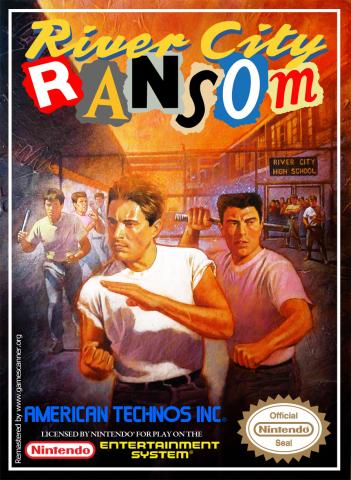River City Ransom Review
Gallery

“Beat ‘em ups” (sometimes referred to as brawlers) are a beautiful genre in their simplicity. You walk in one direction, usually with a friend in co-op, fighting your way through hordes of enemies. You punch, kick, throw and use any weapon you can find to tear apart your attackers. The plots of these games were love letters to every kung fu flick, crime drama or revenge driven action movie. Amidst the golden age of beat ‘em ups Double Dragon, Final Fight, Streets of Rage, and Golden Axe were considered the pioneers of the generation. But River City Ransom was notable for being innovative for including RPG elements and open exploration.
River City Ransom was released in 1990 by Technos for the NES. The story of this game involves a kidnapped girlfriend, an unspecified ransom, and a city full of street gangs straight out of a greaser flick. You play as Alex or Ryan, tough teens who speak with their fists and feet to get the girl back. The plot is pretty irrelevant but that doesn’t matter; it works simply in the context it is set in. The gameplay itself has the components of every beat ‘em up from that era and takes it up to eleven with its own quirks.
Unlike other brawlers this game is open world in the sense that you move between areas at will, giving the player more freedom. You are able to run from a fight, back track to previous areas, or look for a specific gang to encounter. RCR is also very humorous in a slap stick fashion. The look of the game uses charming deformed characters models, funny fight animations, and odd dialogue, such as thugs shouting “barf” as they are defeated. It doesn’t take itself too seriously, unlike most brawlers at the time.
Lives and credits are done away with and instead the penalty for dying is losing half of your money and being carted off to the last mall you visited. It can be a little tedious, especially if you were grinding for cash, but it’s better than a traditional lives system.
The biggest draw is its RPG elements which are represented through buying items. Basically the thugs you beat down will drop money and as you accumulate more funds you can buy items to increase your stats, health, or expand your move set. You are free to level which stats you see fit, depending on your play style. Malls act as the hub for business and are the only areas in the game where roving packs of youth are not out for your blood.
RCR also has its share of flaws. The game is a bit short, though it still manages to be longer than the average brawler. Saved progress is done through a password system but entering in the password is long and complicated; you’ll definitely need a pen and paper. The exploration is nice but the world is very linear, leaving much to be desired for more an open world with multiple paths.
In 2004, the game was remade and released for the GBA, titled River City Ransom Ex, developed by Million and published by Atlus. This version enhanced everything; you have access to a larger move set, new items, more gangs, extra bosses, expanded story sequences, adjustable difficulty at will, and an improved save system. One of the most notable changes was the lack of co-op gameplay with a friend, but the ability to have an AI controlled partner from the start or recruit other characters you find to form a posse.
After you beat RCR EX once (or through the use of cheats) you can have access to special items that let you customize your own characters, which is the most innovative thing this game has to offer. With these items you can alter the configuration of your special attacks, change the physical appearance of your fighter, combine two saved characters into one, or upload a boss as a playable character. My biggest gripe with the remake is that it did not attempt to expand the game’s linear world. I feel the developers missed a great opportunity to finally make a true open world brawler as they had better technology this time around.
Whether you play the classic original or the ambitious remake both games are great brawlers that deserve praise. Though this genre is mostly dead nowadays, this is an example of when it was alive and thriving; the best a forgotten generation has to offer.
(Both games) Grade: B
